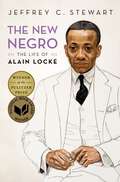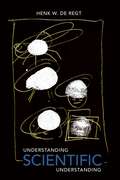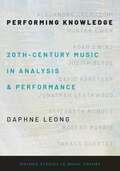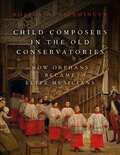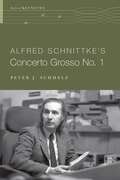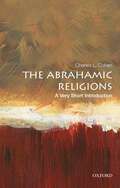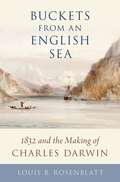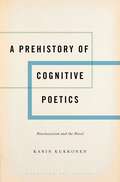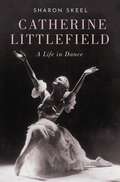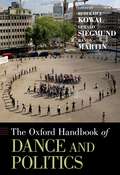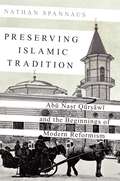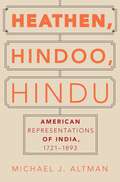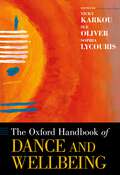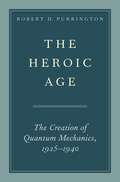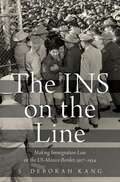- Table View
- List View
The New Negro: The Life of Alain Locke
by Jeffrey C. StewartWinner of the 2018 Pulitzer Prize for Biography Winner of the 2018 National Book Award for Nonfiction A tiny, fastidiously dressed man emerged from Black Philadelphia around the turn of the century to mentor a generation of young artists including Langston Hughes, Zora Neale Hurston, and Jacob Lawrence and call them the New Negro -- the creative African Americans whose art, literature, music, and drama would inspire Black people to greatness. In The New Negro: The Life of Alain Locke, Jeffrey C. Stewart offers the definitive biography of the father of the Harlem Renaissance, based on the extant primary sources of his life and on interviews with those who knew him personally. He narrates the education of Locke, including his becoming the first African American Rhodes Scholar and earning a PhD in philosophy at Harvard University, and his long career as a professor at Howard University. Locke also received a cosmopolitan, aesthetic education through his travels in continental Europe, where he came to appreciate the beauty of art and experienced a freedom unknown to him in the United States. And yet he became most closely associated with the flowering of Black culture in Jazz Age America and his promotion of the literary and artistic work of African Americans as the quintessential creations of American modernism. In the process he looked to Africa to find the proud and beautiful roots of the race. Shifting the discussion of race from politics and economics to the arts, he helped establish the idea that Black urban communities could be crucibles of creativity. Stewart explores both Locke's professional and private life, including his relationships with his mother, his friends, and his white patrons, as well as his lifelong search for love as a gay man. Stewart's thought-provoking biography recreates the worlds of this illustrious, enigmatic man who, in promoting the cultural heritage of Black people, became -- in the process -- a New Negro himself.
Understanding Scientific Understanding (Oxford Studies in Philosophy of Science)
by Henk W. de RegtIt is widely acknowledged that a central aim of science is to achieve understanding of the world around us, and that possessing such understanding is highly important in our present-day society. But what does it mean to achieve this understanding? What precisely is scientific understanding? These are philosophical questions that have not yet received satisfactory answers. While there has been an ongoing debate about the nature of scientific explanation since Carl Hempel advanced his covering-law model in 1948, the related notion of understanding has been largely neglected, because most philosophers regarded understanding as merely a subjective by-product of objective explanations. By contrast, this book puts scientific understanding center stage. It is primarily a philosophical study, but also contains detailed historical case studies of scientific practice. In contrast to most existing studies in this area, it takes into account scientists' views and analyzes their role in scientific debate and development. The aim of Understanding Scientific Understanding is to develop and defend a philosophical theory of scientific understanding that can describe and explain the historical variation of criteria for understanding actually employed by scientists. The theory does justice to the insights of such famous physicists as Werner Heisenberg and Richard Feynman, while bringing much-needed conceptual rigor to their intuitions. The scope of the proposed account of understanding is the natural sciences: while the detailed case studies derive from physics, examples from other sciences are presented to illustrate its wider validity.
Understanding Scientific Understanding: Philosophical Perspectives (Oxford Studies in Philosophy of Science)
by Henk W. de RegtIt is widely acknowledged that a central aim of science is to achieve understanding of the world around us, and that possessing such understanding is highly important in our present-day society. But what does it mean to achieve this understanding? What precisely is scientific understanding? These are philosophical questions that have not yet received satisfactory answers. While there has been an ongoing debate about the nature of scientific explanation since Carl Hempel advanced his covering-law model in 1948, the related notion of understanding has been largely neglected, because most philosophers regarded understanding as merely a subjective by-product of objective explanations. By contrast, this book puts scientific understanding center stage. It is primarily a philosophical study, but also contains detailed historical case studies of scientific practice. In contrast to most existing studies in this area, it takes into account scientists' views and analyzes their role in scientific debate and development. The aim of Understanding Scientific Understanding is to develop and defend a philosophical theory of scientific understanding that can describe and explain the historical variation of criteria for understanding actually employed by scientists. The theory does justice to the insights of such famous physicists as Werner Heisenberg and Richard Feynman, while bringing much-needed conceptual rigor to their intuitions. The scope of the proposed account of understanding is the natural sciences: while the detailed case studies derive from physics, examples from other sciences are presented to illustrate its wider validity.
Performing Knowledge: Twentieth-Century Music in Analysis and Performance (Oxford Studies in Music Theory)
by Daphne LeongHow do musical analysis and performance relate? In a unique collaborative approach to this question, theorist-pianist Daphne Leong partners with internationally renowned performers to interpret twentieth-century repertoire. Imaginative explorations of music by Ravel, Schoenberg, Bartók, Schnittke, Milhaud, Messiaen, Babbitt, Carter, and Morris illuminate focal issues such as the role of embodiment, the affordances of a score, the cultural understanding of notation, the use of metaphor, and--to round out the viewpoints of theorist and performers with those of composer and listeners--the role of structure in audience reception. Each exploration engages deeply with musical structure, redefined to encompass the creative activity of composers, performers, analysts, and listeners. Performances, demonstrations, and interviews online complement the book's written text; practical application and pedagogical guidance round out theoretical and analytical content. The collaborations themselves demonstrate different dimensions of knowledge at the intersection of analysis and performance, and illustrate Leong's theory of the things and people that facilitate cross-disciplinary collaboration in music. They also exemplify the antagonisms and synergies that emerge when theorists and performers meet. Both flexibly and rigorously conceived, Performing Knowledge is a brave crossing of disciplinary divides between scholarship and practice, a work of analysis shaped by the voices of performers.
PERFORMING KNOWLEDGE OXSMT C: Twentieth-Century Music in Analysis and Performance (Oxford Studies in Music Theory)
by Daphne LeongHow do musical analysis and performance relate? In a unique collaborative approach to this question, theorist-pianist Daphne Leong partners with internationally renowned performers to interpret twentieth-century repertoire. Imaginative explorations of music by Ravel, Schoenberg, Bartók, Schnittke, Milhaud, Messiaen, Babbitt, Carter, and Morris illuminate focal issues such as the role of embodiment, the affordances of a score, the cultural understanding of notation, the use of metaphor, and--to round out the viewpoints of theorist and performers with those of composer and listeners--the role of structure in audience reception. Each exploration engages deeply with musical structure, redefined to encompass the creative activity of composers, performers, analysts, and listeners. Performances, demonstrations, and interviews online complement the book's written text; practical application and pedagogical guidance round out theoretical and analytical content. The collaborations themselves demonstrate different dimensions of knowledge at the intersection of analysis and performance, and illustrate Leong's theory of the things and people that facilitate cross-disciplinary collaboration in music. They also exemplify the antagonisms and synergies that emerge when theorists and performers meet. Both flexibly and rigorously conceived, Performing Knowledge is a brave crossing of disciplinary divides between scholarship and practice, a work of analysis shaped by the voices of performers.
Child Composers in the Old Conservatories: How Orphans Became Elite Musicians
by Robert O. GjerdingenIn seventeenth century Italy, overcrowding, violent political uprising, and plague led an astonishing number of abandoned and orphaned children to overwhelm the cities. Out of the piety of private citizens and the apathy of local governments, the system of conservatori was created to house, nurture, and train these fanciulli vaganti (roaming children) to become hatters, shoemakers, tailors, goldsmiths, cabinet makers, and musicians - a range of practical trades that might sustain them and enable them to contribute to society. Conservatori were founded across Italy, from Venice and Florence to Parma and Naples, many specializing in a particular trade. Four music conservatori in Naples gained particular renown for their exceptional training of musicians, both performers and composers, all boys. By the eighteenth century, the graduates of the Naples conservatories began to spread across Europe, with some 600 boys formerly in residence beginning to dominate the European musical world. Other conservatories in the country - including the Paris Conservatory - began to imitate the principles of the Naples' conservatory's training, known as the partimento tradition. The daily lessons and exercises associated with this tradition were largely lost-until author Robert Gjerdingen discovered evidence of them in the archives of conservatories across Italy and the rest of Europe. Compellingly narrated and richly illustrated, Child Composers in the Old Conservatory follows the story of these boys as they undergo rigorous training with the conservatory's maestri and eventually become maestri themselves, then moves forward in time to see the influence of partimenti in the training of such composers as Claude Debussy and Colette Boyer. Advocating for the revival of partimenti in modern music education, the book explores the tremendous potential of this tradition to enable natural musical fluency for students of all ages learning the craft today.
Child Composers in the Old Conservatories: How Orphans Became Elite Musicians
by Robert O. GjerdingenIn seventeenth century Italy, overcrowding, violent political uprising, and plague led an astonishing number of abandoned and orphaned children to overwhelm the cities. Out of the piety of private citizens and the apathy of local governments, the system of conservatori was created to house, nurture, and train these fanciulli vaganti (roaming children) to become hatters, shoemakers, tailors, goldsmiths, cabinet makers, and musicians - a range of practical trades that might sustain them and enable them to contribute to society. Conservatori were founded across Italy, from Venice and Florence to Parma and Naples, many specializing in a particular trade. Four music conservatori in Naples gained particular renown for their exceptional training of musicians, both performers and composers, all boys. By the eighteenth century, the graduates of the Naples conservatories began to spread across Europe, with some 600 boys formerly in residence beginning to dominate the European musical world. Other conservatories in the country - including the Paris Conservatory - began to imitate the principles of the Naples' conservatory's training, known as the partimento tradition. The daily lessons and exercises associated with this tradition were largely lost-until author Robert Gjerdingen discovered evidence of them in the archives of conservatories across Italy and the rest of Europe. Compellingly narrated and richly illustrated, Child Composers in the Old Conservatory follows the story of these boys as they undergo rigorous training with the conservatory's maestri and eventually become maestri themselves, then moves forward in time to see the influence of partimenti in the training of such composers as Claude Debussy and Colette Boyer. Advocating for the revival of partimenti in modern music education, the book explores the tremendous potential of this tradition to enable natural musical fluency for students of all ages learning the craft today.
Alfred Schnittke's Concerto Grosso no. 1 (The Oxford Keynotes Series)
by Peter J. SchmelzConcerto Grosso no. 1 is one of Alfred Schnittke's best-known and most compelling works, sounding the surface of late Soviet life while resonating with contemporary compositional currents around the world such as postmodernism. It marked a decisive point in Schnittke's development of the approach he called polystylism, which aimed to contain in a single composition the wide range of contemporary musical styles, including "jazz, pop, rock, or serial music." Thanks to it and his other similar compositions, Schnittke became one of the most-performed and most-recorded living composers at the end of the twentieth century. Peter J. Schmelz's Alfred Schnittke's Concerto Grosso no. 1 represents the first accessible and comprehensive study of this composition. The novel structure of the book engages with the piece conceptually, historically, musically, and phenomenologically, with the six movements of the composition framing the six chapters. Augmenting and complicating the insights of existing English, Russian, and German publications on the Concerto Grosso no. 1, the book adds new information from underused primary sources, including Schnittke's unpublished correspondence and his many published interviews. It engages further with his sketches for the piece, and with contemporary Soviet musical criticism, resulting in a more objective, historical account of this rich, multifaceted composition, its influences, and its impact on music making in the USSR and worldwide.
ALFRED SCHNIT CONCER GROSSO NO. 1 OKS C (The Oxford Keynotes Series)
by Peter J. SchmelzConcerto Grosso no. 1 is one of Alfred Schnittke's best-known and most compelling works, sounding the surface of late Soviet life while resonating with contemporary compositional currents around the world such as postmodernism. It marked a decisive point in Schnittke's development of the approach he called polystylism, which aimed to contain in a single composition the wide range of contemporary musical styles, including "jazz, pop, rock, or serial music." Thanks to it and his other similar compositions, Schnittke became one of the most-performed and most-recorded living composers at the end of the twentieth century. Peter J. Schmelz's Alfred Schnittke's Concerto Grosso no. 1 represents the first accessible and comprehensive study of this composition. The novel structure of the book engages with the piece conceptually, historically, musically, and phenomenologically, with the six movements of the composition framing the six chapters. Augmenting and complicating the insights of existing English, Russian, and German publications on the Concerto Grosso no. 1, the book adds new information from underused primary sources, including Schnittke's unpublished correspondence and his many published interviews. It engages further with his sketches for the piece, and with contemporary Soviet musical criticism, resulting in a more objective, historical account of this rich, multifaceted composition, its influences, and its impact on music making in the USSR and worldwide.
The Abrahamic Religions: A Very Short Introduction (Very Short Introductions)
by Charles L. CohenIn the book of Genesis, God bestows a new name upon Abram--Abraham, a father of many nations. With this name and his Covenant, Abraham would become the patriarch of three of the world's major religions: Judaism, Christianity, and Islam. Connected by their mutual--if differentiated--veneration of the One God proclaimed by Abraham, these traditions share much beyond their origins in the ancient Israel of the Old Testament. This Very Short Introduction explores the intertwined histories of these monotheistic religions, from the emergence of Christianity and Islam to the violence of the Crusades and the cultural exchanges of al-Andalus. Each religion continues to be shaped by this history but has also reacted to the forces of modernity and politics. Movements such as the Reformation and that led by seventh-century Kharijites have emerged, intentioned to reform or restore traditional religious practice but quite different in their goals and effects. Relationships with states, among them Israel and Saudi Arabia, have also figured importantly in their development. The Abrahamic Religions: A Very Short Introduction brings these traditions together into a common narrative, lending much needed context to the story of Abraham and his descendants. ABOUT THE SERIES: The Very Short Introductions series from Oxford University Press contains hundreds of titles in almost every subject area. These pocket-sized books are the perfect way to get ahead in a new subject quickly. Our expert authors combine facts, analysis, perspective, new ideas, and enthusiasm to make interesting and challenging topics highly readable.
The Abrahamic Religions: A Very Short Introduction (Very Short Introductions)
by Charles L. CohenIn the book of Genesis, God bestows a new name upon Abram--Abraham, a father of many nations. With this name and his Covenant, Abraham would become the patriarch of three of the world's major religions: Judaism, Christianity, and Islam. Connected by their mutual--if differentiated--veneration of the One God proclaimed by Abraham, these traditions share much beyond their origins in the ancient Israel of the Old Testament. This Very Short Introduction explores the intertwined histories of these monotheistic religions, from the emergence of Christianity and Islam to the violence of the Crusades and the cultural exchanges of al-Andalus. Each religion continues to be shaped by this history but has also reacted to the forces of modernity and politics. Movements such as the Reformation and that led by seventh-century Kharijites have emerged, intentioned to reform or restore traditional religious practice but quite different in their goals and effects. Relationships with states, among them Israel and Saudi Arabia, have also figured importantly in their development. The Abrahamic Religions: A Very Short Introduction brings these traditions together into a common narrative, lending much needed context to the story of Abraham and his descendants. ABOUT THE SERIES: The Very Short Introductions series from Oxford University Press contains hundreds of titles in almost every subject area. These pocket-sized books are the perfect way to get ahead in a new subject quickly. Our expert authors combine facts, analysis, perspective, new ideas, and enthusiasm to make interesting and challenging topics highly readable.
Buckets from an English Sea: 1832 and the Making of Charles Darwin
by Louis B. RosenblattDarwin did not discover evolution. He didn't trip over it on the way to somewhere else the way Columbus discovered the New World. Like the atom, planetary orbits, and so many other scientific constructs, evolution was invented in order to explain striking phenomena. And it has been most successful. A century and a half has not simply confirmed Darwin's work, it has linked evolution to the mechanisms of life on the molecular scale. It is what life does. Where Darwin had drawn his theories from forest and field, we now set them in the coiling and uncoiling of twists of DNA, linking where they might, with a host of molecular bits and pieces scurrying about. Darwin, himself, however, has been a closed story. A century and a half of study of the man and his work, including close readings of his books, his notebooks and letters, and even the books he read, has led to a working appreciation of his genius. The 'success' of this account has, however, kept us from seeing several important issues: most notably, why did he pursue evolution in the first place? Buckets from an English Sea offers a new view of what inspired Darwin and provoked his work. Stunning events early in the voyage of the Beagle challenged his deeply held conviction that people are innately good. This study of 1832 highlights the resources available to the young Darwin as he worked to secure humanity's innate goodness.
Buckets from an English Sea: 1832 and the Making of Charles Darwin
by Louis B. RosenblattDarwin did not discover evolution. He didn't trip over it on the way to somewhere else the way Columbus discovered the New World. Like the atom, planetary orbits, and so many other scientific constructs, evolution was invented in order to explain striking phenomena. And it has been most successful. A century and a half has not simply confirmed Darwin's work, it has linked evolution to the mechanisms of life on the molecular scale. It is what life does. Where Darwin had drawn his theories from forest and field, we now set them in the coiling and uncoiling of twists of DNA, linking where they might, with a host of molecular bits and pieces scurrying about. Darwin, himself, however, has been a closed story. A century and a half of study of the man and his work, including close readings of his books, his notebooks and letters, and even the books he read, has led to a working appreciation of his genius. The 'success' of this account has, however, kept us from seeing several important issues: most notably, why did he pursue evolution in the first place? Buckets from an English Sea offers a new view of what inspired Darwin and provoked his work. Stunning events early in the voyage of the Beagle challenged his deeply held conviction that people are innately good. This study of 1832 highlights the resources available to the young Darwin as he worked to secure humanity's innate goodness.
A Prehistory of Cognitive Poetics: Neoclassicism and the Novel (Cognition and Poetics)
by Karin KukkonenThis study provides an introduction to the neoclassical debates around how literature is shaped in concert with the thinking and feeling human mind. Three key rules of neoclassicism, namely, poetic justice (the rewards and punishments of characters in the plot), the unities (the coherence of the fictional world and its extensions through the imagination) and decorum (the inferential connections between characters and their likely actions), are reconsidered in light of social cognition, embodied cognition and probabilistic, predictive cognition. The meeting between neoclassical criticism and today's research psychology, neurology and philosophy of mind yields a new perspective for cognitive literary study. Neoclassicism has a crucial contribution to make to current debates around the role of literature in cultural and cognition. Literary critics writing at the time of the scientific revolution developed a perspective on literature the question of how literature engages minds and bodies as its central concern. A Prehistory of Cognitive Poetics traces the cognitive dimension of these critical debates in seventeenth- and eighteenth-century Britain and puts them into conversation with today's cognitive approaches to literature. Neoclassical theory is then connected to the praxis of eighteenth-century writers in a series of case studies that trace how these principles shaped the emerging narrative form of the novel. The continuing relevance of neoclassicism also shows itself in the rise of the novel, as A Prehistory of Cognitive Poetics illustrates through examples including Pamela, Tom Jones and the Gothic novel.
Catherine Littlefield: A Life in Dance
by Sharon SkeelWhile she is best remembered today as founder of the Philadelphia Ballet and the director and driving force behind the famous Littlefield School of Ballet, from which Balanchine drew the nucleus for his School of American Ballet, Catherine Littlefield (1905-51) and her oeuvre were in many ways emblematic of the full representation of dance throughout entertainments of the first half of the 20th century. From her early work as a teenager dancing for Florenz Ziegfeld to her later work in choreographing extravagant ice skating shows, a remarkable dance with 90 bicyclists for the 1940 World's Fair, and on television as resident choreographer for The Jimmy Durante Show, Littlefield was amongst the first choreographers to bring concert dance to broader venues, and her legacy lives on today in her enduring influence on generations of American ballet dancers. As the first biography of Littlefield, Catherine Littlefield: A Life in Dance traces her life in full from birth through childhood experiences dancing on the Academy of Music's grand stage, and from her foundation of the groundbreaking Philadelphia Ballet Company in 1935 to her later work in television and beyond. Littlefield counted among her many glamorous friends and colleagues writer Zelda Fitzgerald, conductor Leopold Stokowski, and composer Kurt Weill. This biography also provides an engrossing portrait of the remarkable Littlefield family, many of whom were instrumental to Catherine's success. With the unflagging support of her generous husband and indomitable mother, Littlefield gave shape to the course of American ballet in the 20th century long before Balanchine arrived in the United States.
Catherine Littlefield: A Life in Dance
by Sharon SkeelWhile she is best remembered today as founder of the Philadelphia Ballet and the director and driving force behind the famous Littlefield School of Ballet, from which Balanchine drew the nucleus for his School of American Ballet, Catherine Littlefield (1905-51) and her oeuvre were in many ways emblematic of the full representation of dance throughout entertainments of the first half of the 20th century. From her early work as a teenager dancing for Florenz Ziegfeld to her later work in choreographing extravagant ice skating shows, a remarkable dance with 90 bicyclists for the 1940 World's Fair, and on television as resident choreographer for The Jimmy Durante Show, Littlefield was amongst the first choreographers to bring concert dance to broader venues, and her legacy lives on today in her enduring influence on generations of American ballet dancers. As the first biography of Littlefield, Catherine Littlefield: A Life in Dance traces her life in full from birth through childhood experiences dancing on the Academy of Music's grand stage, and from her foundation of the groundbreaking Philadelphia Ballet Company in 1935 to her later work in television and beyond. Littlefield counted among her many glamorous friends and colleagues writer Zelda Fitzgerald, conductor Leopold Stokowski, and composer Kurt Weill. This biography also provides an engrossing portrait of the remarkable Littlefield family, many of whom were instrumental to Catherine's success. With the unflagging support of her generous husband and indomitable mother, Littlefield gave shape to the course of American ballet in the 20th century long before Balanchine arrived in the United States.
The Oxford Handbook of Dance and Politics (Oxford Handbooks)
by Rebekah J. Kowal, Gerald Siegmund and Randy MartinIn recent decades, dance has become a vehicle for querying assumptions about what it means to be embodied, in turn illuminating intersections among the political, the social, the aesthetical, and the phenomenological. The Oxford Handbook of Dance and Politics edited by internationally lauded scholars Rebekah Kowal, Gerald Siegmund, and the late Randy Martin presents a compendium of newly-commissioned chapters that address the interdisciplinary and global scope of dance theory - its political philosophy, social movements, and approaches to bodily difference such as disability, postcolonial, and critical race and queer studies. In six sections 30 of the most prestigious dance scholars in the US and Europe track the political economy of dance and analyze the political dimensions of choreography, of writing history, and of embodied phenomena in general. Employing years of intimate knowledge of dance and its cultural phenomenology, scholars urge readers to re-think dominant cultural codes, their usages, and the meaning they produce and theorize ways dance may help to re-signify and to re-negotiate established cultural practices and their inherent power relations. This handbook poses ever-present questions about dance politics-which aspects or effects of a dance can be considered political? What possibilities and understandings of politics are disclosed through dance? How does a particular dance articulate or undermine forces of authority? How might dance relate to emancipation or bondage of the body? Where and how can dance articulate social movements, represent or challenge political institutions, or offer insight into habits of labor and leisure? The handbook opens its critical terms in two directions. First, it offers an elaborated understanding of how dance achieves its politics. Second, it illustrates how notions of the political are themselves expanded when viewed from the perspective of dance, thus addressing both the relationship between the politics in dance and the politics of dance. Using the most sophisticated theoretical frameworks and engaging with the problematics that come from philosophy, social science, history, and the humanities, chapters explore the affinities, affiliations, concepts, and critiques that are inherent in the act of dance, and questions about matters political that dance makes legible.
Preserving Islamic Tradition: Abu Nasr Qursawi and the Beginnings of Modern Reformism
by Nathan SpannausThe end of the eighteenth century was a transformational period for the Muslim communities of the Russian Empire and their relationship with the tsarist state. Though they had been under Russian rule since the sixteenth century, it was at this time that they were incorporated into the imperial bureaucracy, most significantly through the founding of an official hierarchy for the Islamic religious scholars in 1788. The introduction of a state-backed structure for Muslim religious institutions altered Islamic religious authority and, in turn, religious discourse. One of the major figures to emerge from this new context was Abu Nasr Qursawi (1776-1812). A controversial figure who was condemned for heresy in Bukhara in 1808, Qursawi put forward a sweeping reform of the Islamic scholarly tradition. Focusing on taqlid, the principle of conformity to established doctrine, Qursawi argued that its overuse had weakened scholarship in the areas of Islamic law (fiqh) and theology (kalam) and undermined scholars' ability to serve as religious guides. In Preserving Islamic Tradition, Nathan Spannaus presents the first detailed analysis of Qursawi's reformist project, both in its contours and broad historical setting. Spannaus shows how state control of Muslim institutions impacted religious discourse, but also how it altered the entire religious environment into the twentieth century. Addressing issues of modernity, secularity, tradition, and intellectual history, Preserving Islamic Tradition demonstrates how the interaction with a European imperial state transformed the Islamic tradition, both directly and indirectly, and elicited new forms of religious thought and discourse.
Heathen, Hindoo, Hindu: American Representations of India, 1721-1893
by Michael J. AltmanToday, there are more than two million Hindus in America. But before the twentieth century, Hinduism was unknown in the United States. But while Americans did not write about "Hinduism," they speculated at length about "heathenism," "the religion of the Hindoos," and "Brahmanism." In Heathen, Hindoo, Hindu, Michael J. Altman argues that this is not a mere sematic distinction-a case of more politically correct terminology being accepted over time-but a way that Americans worked out their own identities. American representations of India said more about Americans than about Hindus. Cotton Mather, Hannah Adams, and Joseph Priestley engaged the larger European Enlightenment project of classifying and comparing religion in India. Evangelical missionaries used images of "Hindoo heathenism" to raise support at home. Unitarian Protestants found a kindred spirit in the writings of Bengali reformer Rammohun Roy. Popular magazines and common school books used the image of dark, heathen, despotic India to buttress Protestant, white, democratic American identity. Transcendentalists and Theosophists imagined the contemplative and esoteric religion of India as an alternative to materialist American Protestantism. Hindu delegates and American speakers at the 1893 World's Parliament of Religions engaged in a protracted debate about the definition of religion in industrializing America. Heathen, Hindoo, Hindu is a groundbreaking analysis of American representations of religion in India before the turn of the twentieth century. Altman reorients American religious history and the history of Asian religions in America, showing how Americans of all sorts imagined India for their own purposes. The questions that animated descriptions of heathens, Hindoos, and Hindus in the past, he argues, still animate American debates today.
Heathen, Hindoo, Hindu: American Representations of India, 1721-1893
by Michael J. AltmanToday, there are more than two million Hindus in America. But before the twentieth century, Hinduism was unknown in the United States. But while Americans did not write about "Hinduism," they speculated at length about "heathenism," "the religion of the Hindoos," and "Brahmanism." In Heathen, Hindoo, Hindu, Michael J. Altman argues that this is not a mere sematic distinction-a case of more politically correct terminology being accepted over time-but a way that Americans worked out their own identities. American representations of India said more about Americans than about Hindus. Cotton Mather, Hannah Adams, and Joseph Priestley engaged the larger European Enlightenment project of classifying and comparing religion in India. Evangelical missionaries used images of "Hindoo heathenism" to raise support at home. Unitarian Protestants found a kindred spirit in the writings of Bengali reformer Rammohun Roy. Popular magazines and common school books used the image of dark, heathen, despotic India to buttress Protestant, white, democratic American identity. Transcendentalists and Theosophists imagined the contemplative and esoteric religion of India as an alternative to materialist American Protestantism. Hindu delegates and American speakers at the 1893 World's Parliament of Religions engaged in a protracted debate about the definition of religion in industrializing America. Heathen, Hindoo, Hindu is a groundbreaking analysis of American representations of religion in India before the turn of the twentieth century. Altman reorients American religious history and the history of Asian religions in America, showing how Americans of all sorts imagined India for their own purposes. The questions that animated descriptions of heathens, Hindoos, and Hindus in the past, he argues, still animate American debates today.
The Oxford Handbook of Dance and Wellbeing (Oxford Handbooks)
by Vicky Karkou, Sue Oliver and Sophia LycourisIn recent years, a growth in dance and wellbeing scholarship has resulted in new ways of thinking that place the body, movement, and dance in a central place with renewed significance for wellbeing. The Oxford Handbook of Dance and Wellbeing examines dance and related movement practices from the perspectives of neuroscience and health, community and education, and psychology and sociology to contribute towards an understanding of wellbeing, offer new insights into existing practices, and create a space where sufficient exchange is enabled. The handbook's research components include quantitative, qualitative, and arts-based research, covering diverse discourses, methodologies, and perspectives that add to the development of a complete picture of the topic. Throughout the handbook's wide-ranging chapters, the objective observations, felt experiences, and artistic explorations of practitioners interact with and are printed alongside academic chapters to establish an egalitarian and impactful exchange of ideas.
The Heroic Age: The Creation of Quantum Mechanics, 1925-1940
by Robert D. PurringtonQuantum theory is one of the great achievements of twentieth century physics. Born at the very beginning of the century, it attained a definitive form by 1932, yet continued to evolve throughout the century. Its applications remain fully a part of modern life. It should thus come as no surprise that literature on the history of quantum theory is vast, but author Robert D. Purrington approaches the story from a new angle, by examining the original physics papers and scientific studies from before the creation of quantum mechanics to how scientists think about and discuss the subject today. The Heroic Age presents for the first time a detailed but compact and manageable history of the creation of quantum theory, and shows precisely where each important idea originated. Purrington provides the history of the crucial developmental years of quantum theory with an emphasis on the literature rather than an overview of this period focusing on personalities or personal stories of the scientists involved. This book instead focuses on how the theoretical discoveries came about, when and where they were published, and how they became accepted as part of the scientific canon.
The Heroic Age: The Creation of Quantum Mechanics, 1925-1940
by Robert D. PurringtonQuantum theory is one of the great achievements of twentieth century physics. Born at the very beginning of the century, it attained a definitive form by 1932, yet continued to evolve throughout the century. Its applications remain fully a part of modern life. It should thus come as no surprise that literature on the history of quantum theory is vast, but author Robert D. Purrington approaches the story from a new angle, by examining the original physics papers and scientific studies from before the creation of quantum mechanics to how scientists think about and discuss the subject today. The Heroic Age presents for the first time a detailed but compact and manageable history of the creation of quantum theory, and shows precisely where each important idea originated. Purrington provides the history of the crucial developmental years of quantum theory with an emphasis on the literature rather than an overview of this period focusing on personalities or personal stories of the scientists involved. This book instead focuses on how the theoretical discoveries came about, when and where they were published, and how they became accepted as part of the scientific canon.
The INS on the Line: Making Immigration Law on the US-Mexico Border, 1917-1954
by S. Deborah KangFor much of the twentieth century, Immigration and Naturalization Service (INS) officials recognized that the US-Mexico border region was different. Here, they confronted a set of political, social, and environmental obstacles that prevented them from replicating their achievements on Angel Island and Ellis Island, the most restrictive immigration stations in the nation. In response to these challenges, local INS officials resorted to the law, nullifying, modifying, and creating the nation's immigration laws and policies for the borderlands. In The INS on the Line, S. Deborah Kang traces the ways in which the INS on the US-Mexico border made and remade the nation's immigration laws over the course of the twentieth century. Through a nuanced examination of the agency's legal innovations in the Southwest, Kang demonstrates that the agency defined itself not only as a law enforcement unit but also as a lawmaking body. In this role, the INS responded to the interests of local residents, businesses, politicians, and social organizations on both sides of the US-Mexico border as well as policymakers in Washington, DC. Given the sheer variety of local and federal demands, local immigration officials constructed a complex approach to border control, an approach that closed the line in the name of nativism and national security, opened it for the benefit of transnational economic and social concerns, and redefined it as a vast legal jurisdiction for the policing of undocumented immigrants. The composite approach to border control developed by the INS continues to inform the daily operations of the nation's immigration agencies, American immigration law and policy, and conceptions of the US-Mexico border today.
INS ON THE LINE C: Making Immigration Law on the US-Mexico Border, 1917-1954
by S. Deborah KangFor much of the twentieth century, Immigration and Naturalization Service (INS) officials recognized that the US-Mexico border region was different. Here, they confronted a set of political, social, and environmental obstacles that prevented them from replicating their achievements on Angel Island and Ellis Island, the most restrictive immigration stations in the nation. In response to these challenges, local INS officials resorted to the law, nullifying, modifying, and creating the nation's immigration laws and policies for the borderlands. In The INS on the Line, S. Deborah Kang traces the ways in which the INS on the US-Mexico border made and remade the nation's immigration laws over the course of the twentieth century. Through a nuanced examination of the agency's legal innovations in the Southwest, Kang demonstrates that the agency defined itself not only as a law enforcement unit but also as a lawmaking body. In this role, the INS responded to the interests of local residents, businesses, politicians, and social organizations on both sides of the US-Mexico border as well as policymakers in Washington, DC. Given the sheer variety of local and federal demands, local immigration officials constructed a complex approach to border control, an approach that closed the line in the name of nativism and national security, opened it for the benefit of transnational economic and social concerns, and redefined it as a vast legal jurisdiction for the policing of undocumented immigrants. The composite approach to border control developed by the INS continues to inform the daily operations of the nation's immigration agencies, American immigration law and policy, and conceptions of the US-Mexico border today.
